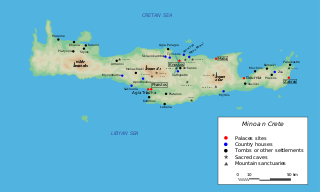
The Minoan civilization was a Bronze Age culture which was centered on the island of Crete. Known for its monumental architecture and its energetic art, it is often regarded as the first civilization in Europe.
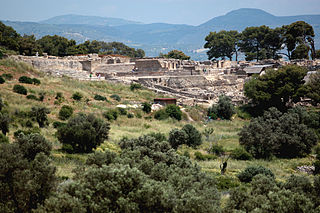
Phaistos ), also transliterated as Phaestos, Festos and Latin Phaestus, is a Bronze Age archaeological site at modern Faistos, a municipality in south central Crete. It is notable for the remains of a Minoan palace and the surrounding town.

A bowl is a typically round dish or container generally used for preparing, serving, storing, or consuming food. The interior of a bowl is characteristically shaped like a spherical cap, with the edges and the bottom forming a seamless curve. This makes bowls especially suited for holding liquids and loose food, as the contents of the bowl are naturally concentrated in its center by the force of gravity. The exterior of a bowl is most often round, but can be of any shape, including rectangular.
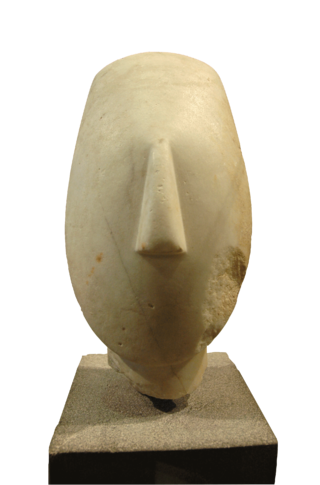
Aegean art is art that was created in the lands surrounding, and the islands within, the Aegean Sea during the Bronze Age, that is, until the 11th century BC, before Ancient Greek art. Because is it mostly found in the territory of modern Greece, it is sometimes called Greek Bronze Age art, though it includes not just the art of the Mycenaean Greeks, but also that of the non-Greek Cycladic and Minoan cultures, which converged over time.

Minoan pottery has been used as a tool for dating the mute Minoan civilization. Its restless sequence of quirky maturing artistic styles reveals something of Minoan patrons' pleasure in novelty while they assist archaeologists in assigning relative dates to the strata of their sites. Pots that contained oils and ointments, exported from 18th century BC Crete, have been found at sites through the Aegean islands and mainland Greece, in Cyprus, along coastal Syria and in Egypt, showing the wide trading contacts of the Minoans.
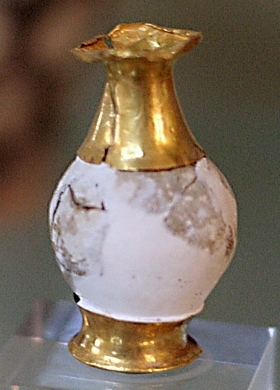
Kamares is a village in south-central Crete, Greece. It is the location of an archaeological site of a Minoan sacred cave. The sacred cave at Kamares is slightly offset from a saddle in the Psiloriti Range virtually aligned with the location of nearby Phaistos. Some of the best examples of Middle Minoan pottery have been recovered from the Kamares cave. Kamares has provided the type name for Kamares ware, a ceramic type dating from MM IA, or the First Palace Period. This pottery is a light-on-dark polychrome ware, with forms including jugs and cups.

The Heraklion Archaeological Museum is a museum located in Heraklion on Crete. It is one of the largest museums in Greece and the best in the world for Minoan art, as it contains by far the most important and complete collection of artefacts of the Minoan civilization of Crete. It is normally referred to scholarship in English as "AMH", a form still sometimes used by the museum in itself.
Aegean script or Cretan script refers to a group of scripts that originate from the island of Crete. It may also refer to:

Vasiliki wares are a distinctive type of Minoan pottery produced in Crete during the Minoan period, named for the finds around the town of Vasiliki, Lasithi, although it was produced at other sites too. The vases include a reddish-brown wash applied unevenly to mimic stone vessels. The mottling was produced by uneven firing of the slip-covered pot, with the hottest areas turning dark. Considering that the mottling was controlled into a pattern, touching with hot coals was probably used to produce it. There is also a style painted in a creamy white over the reddish-brown wash applied all over the body.

Minoan chronology is a measure of the phases of the Minoan civilization. Two systems of relative chronology are used for the Minoans. The first, based on pottery styles, divides Minoan history into three major periods: Early Minoan (EM), Middle Minoan (MM) and Late Minoan (LM). These periods can be divided using Roman numerals, which can be further divided using using capital letters. An alternative system, proposed by Greek archaeologist Nikolaos Platon, divides Minoan history into four periods termed Prepalatial, Protopalatial, Neopalatial, and Postpalatial. Though intended as a replacement for Evans's system, the two are generally used alongside one another.

Mycenaean pottery is the pottery tradition associated with the Mycenaean period in Ancient Greece. It encompassed a variety of styles and forms including the stirrup jar. The term "Mycenaean" comes from the site Mycenae, and was first applied by Heinrich Schliemann.

Kommos is an archaeological site in southern Crete. During the Minoan period, it served as a harbour town for nearby Phaistos and Hagia Triada. After the Bronze Age, a sanctuary was built over the ruins of the earlier town. It is notable for providing evidence about international trade and local daily life.
Teodoro "Doro" Levi was an Italian archaeologist who practiced in the Mediterranean countries in the 20th century. Specifically, Levi conducted excavations in Italy, Greece, and Turkey. From 1938 to 1945, Levi was a member of the Institute for Advanced Study in Princeton, New Jersey. Levi has published a number of technical manuscripts on archaeology such as Festos e la Civiltà Minoica, tavole I published in 1976. Some of Levi's most significant work was a long term excavation at Minoan Phaistos, which site is the second most significant Minoan settlement and which has yielded important finds such as the Phaistos Disk and extensive Bronze Age pottery.
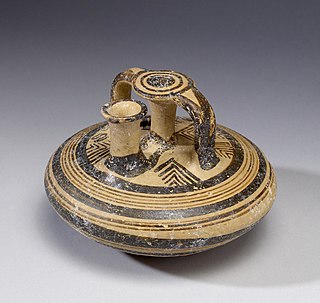
A stirrup jar is a type of pot associated with the culture of Mycenaean Greece. They have small squat bodies, a pouring spout, and a second nonfunctioning spout over which the handles connect like a stirrup. During the Late Bronze Age, they were used in the export of oils, and are found in large numbers at sites around the Eastern Mediterranean and beyond. The term "stirrup-jar" is a translation of German "Bügelkanne", the name assigned to them by Heinrich Schliemann who found the first instances during his excavations at Troy.

Kamares ware is a distinctive type of Minoan pottery produced in Crete during the Minoan period, dating to MM IA. By the LM IA period, or the end of the First Palace Period, these wares decline in distribution and "vitality". They have traditionally been interpreted as a prestige artifact, possibly used as an elite table-ware.

Minoan art is the art produced by the Bronze Age Aegean Minoan civilization from about 3000 to 1100 BC, though the most extensive and finest survivals come from approximately 2300 to 1400 BC. It forms part of the wider grouping of Aegean art, and in later periods came for a time to have a dominant influence over Cycladic art. Since wood and textiles have decomposed, the best-preserved surviving examples of Minoan art are its pottery, palace architecture, small sculptures in various materials, jewellery, metal vessels, and intricately-carved seals.
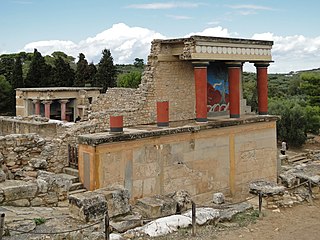
Minoan palaces were massive building complexes built on Crete during the Bronze Age. They are often considered emblematic of the Minoan civilization and are modern tourist destinations. Archaeologists generally recognize five structures as palaces, namely those at Knossos, Phaistos, Malia, Galatas, and Zakros.

Minoan seals are impression seals in the form of carved gemstones and similar pieces in metal, ivory and other materials produced in the Minoan civilization. They are an important part of Minoan art, and have been found in quantity at specific sites, for example in Knossos, Mallia and Phaistos. They were evidently used as a means of identifying documents and objects.
Vrokastro was an ancient Minoan civilization settlement in the Lasithi regional unit of eastern Crete, Greece. It overlooks the Gulf of Mirabello.
The archaeology of Greece includes artificial remains, geographical landscapes, architectural remains, and biofacts. The history of Greece as a country and region is believed to have begun roughly 1–2 million years ago when Homo erectus first colonized Europe. From the first colonization, Greek history follows a sequential pattern of development alike to the rest of Europe. Neolithic, Bronze, Iron and Classical Greece are highlights of the Greek archaeological record, with an array of archaeological finds relevant to these periods.
















